
Photograph showing the interior of the Potthast shop with (left to right) William, Vincent, Theodore, and John Potthast and their accountant (standing), Baltimore, Maryland, ca. 1903. (Courtesy, Potthast family collection.)
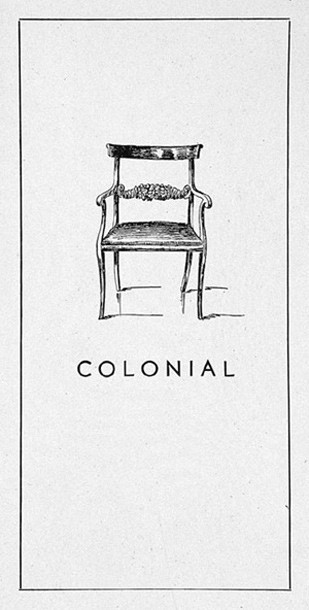
Potthast Bros., Inc., brochure titled “Colonial,” Baltimore, Maryland, ca. 1930. (Private collection.)
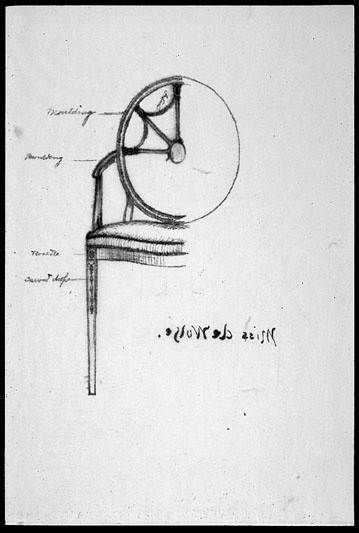
Potthast Bros., Inc., sketch for a chair inscribed “Miss de Wolfe,” Potthast letterbook, 1907, p. 305. (Courtesy, Potthast family collection.)
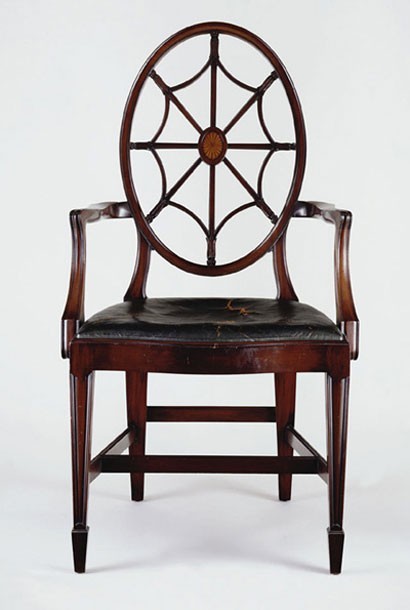
Potthast Bros., Inc., “Huntmaster’s chair,” Baltimore, Maryland, ca. 1917. Mahogany and lightwood inlay with oak. H. 51 1/2", W. 27 1/2", D. 23". (Private collection; photo, Gavin Ashworth.)

Detail of the back of the “Huntmaster’s chair” illustrated in fig. 4.
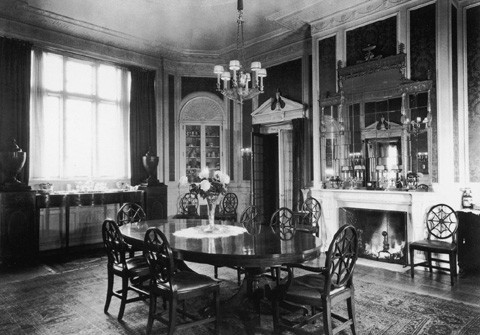
Photograph showing the suite of Potthast furniture commissioned for Pleasant Hill, Baltimore, Maryland, ca. 1920. (Private collection.)

Photograph of William Potthast, Baltimore, Maryland, ca. 1900. (Courtesy, Potthast family collection.)

Photograph of Vincent Potthast, Baltimore, Maryland, ca. 1900. (Courtesy, Potthast family collection.)
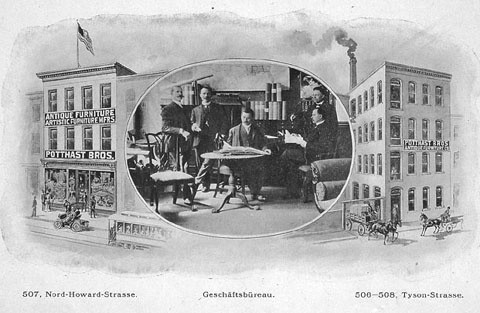
Lithograph showing Potthast Bros., Inc.’s shop at 507 North Howard Street and factory at 506–508 Tyson Street. The photograph of this image is taken from Das Neue Baltimore (1905).

Chest of drawers attributed to William Camp, Baltimore, Maryland, ca. 1820. Mahogany with tulip poplar and yellow pine. H. 41", W. 40 1/2", D. 21 1/4". The Potthasts repaired and labeled this chest about 1903. (Private collection.)
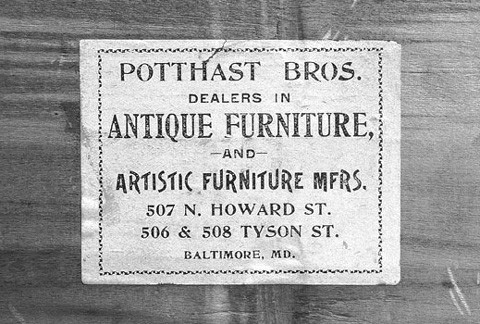
Detail showing the label on the chest illustrated in fig. 10.
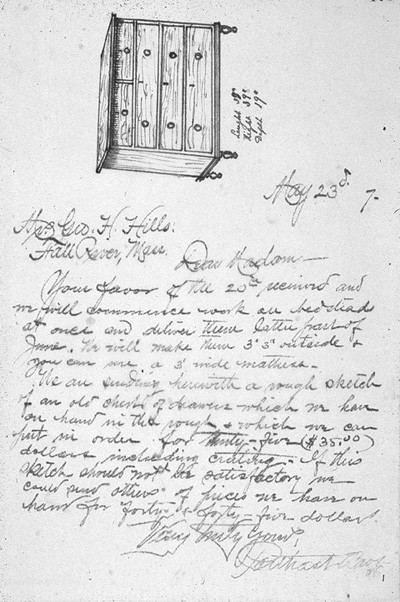
Potthast Bros., Inc., sketch of a chest submitted to Mrs. Geo. Hills, Fall River, Massachusetts, May 23, 1907. This sketch, which resembles the chest illustrated in fig. 10, is in Potthast letterbook, 1907. (Courtesy, Potthast family collection.)
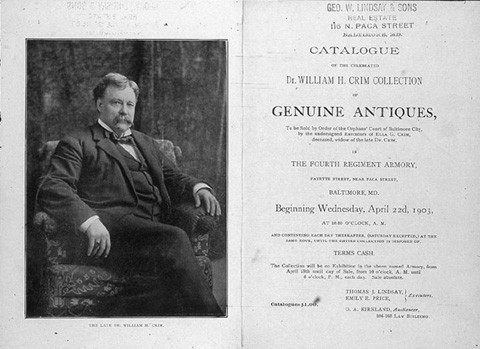
Title page from O. A. Kirkland Auctioneer, Catalogue of the Celebrated Dr. William H. Crim Collection of Genuine Antiques, Baltimore, Maryland, 1903. (Private collection.)

Potthast Bros., Inc., reproduction “Crim chair,” Baltimore, Maryland, ca. 1930. Mahogany with oak. H. 40 1/4", W. 24", D. 17 3/4". (Private collection; photo, Gavin Ashworth.)
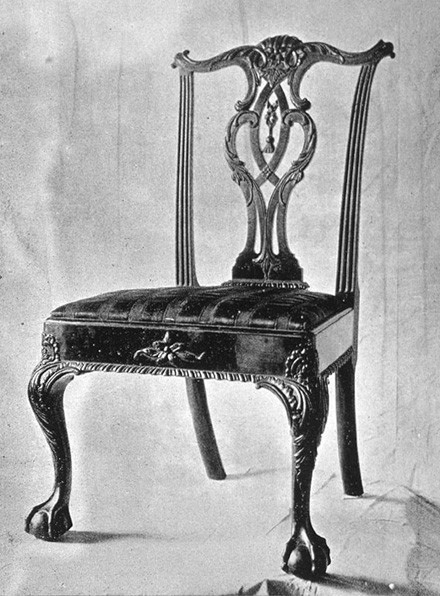
Philadelphia side chair illustrated as lot 231 in O. A. Kirkland Auctioneer, Catalogue of the Celebrated Dr. William H. Crim Collection of Genuine Antiques, Baltimore, Maryland, 1903. (Private collection.)
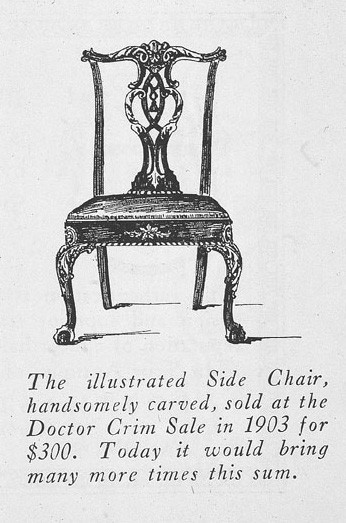
Illustration of a reproduction “Side Chair, handsomely carved, sold at the Dr. Crim Sale” in Potthast Bros., Inc., “Interesting Facts: Inside Secrets of Selecting Furniture Correctly,” Baltimore, Maryland, 1935.
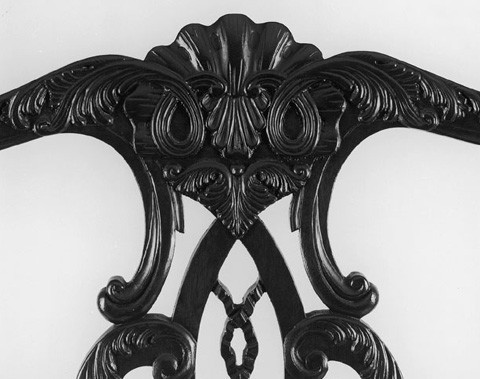
Detail of the carving on the back of the side chair illustrated in fig. 14. (Photo, Gavin Ashworth.)
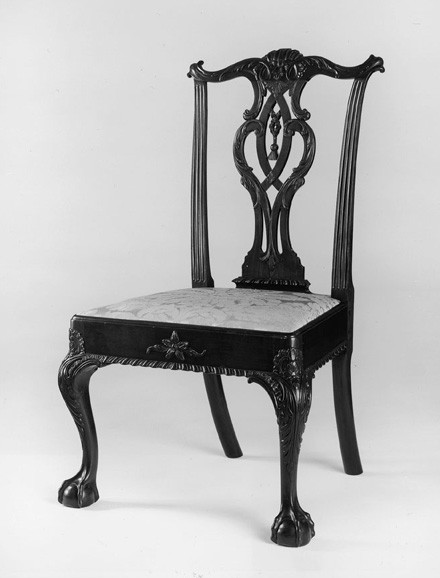
Side chair, Philadelphia, Pennsylvania, ca. 1750. Mahogany with pine. H. 39", W. 24", D. 22 1/2". (Chipstone Foundation; photo, Gavin Ashworth.) This chair sold as lot 231 in O. A. Kirkland Auctioneer, Catalogue of the Celebrated Dr. William H. Crim Collection of Genuine Antiques, Baltimore, Maryland, 1903.

Detail of the carving on the back of the side chair shown in fig. 18.

Armchair illustrated as lot 774 in O. A. Kirkland Auctioneer, Catalogue of the Celebrated Dr. William H. Crim Collection of Genuine Antiques, Baltimore, Maryland, 1903. (Private collection.) This armchair is one of eight that reputedly belonged to Francis Scott Key.

Potthast Bros., Inc., reproduction “Key chair,” Baltimore, Maryland, ca. 1910. Mahogany with oak. H. 36 3/4", W. 23 3/4", D. 20 1/4". (Courtesy, Maryland Historical Society, Baltimore, Maryland.)
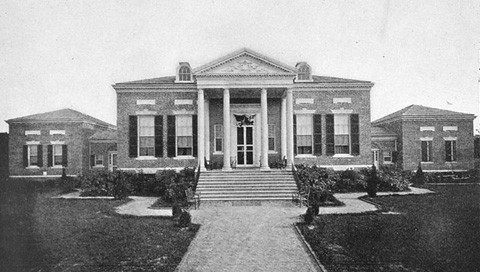
Photograph of the Maryland Building in the 1907 Tercentennial Exposition in Norfolk, Virginia, illustrated in Report of the Maryland Commission to the Jamestown Ter-Centennial Exposition (1908).
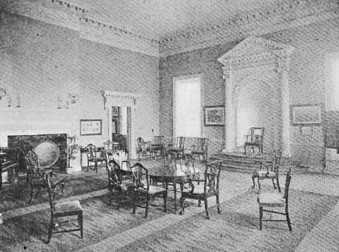
Photograph showing the “Senate Chamber” of the Maryland Building in the 1907 Tercentennial Exposition in Norfolk, Virginia, illustrated in Report of the Maryland Commission to the Jamestown Ter-Centennial Exposition (1908).
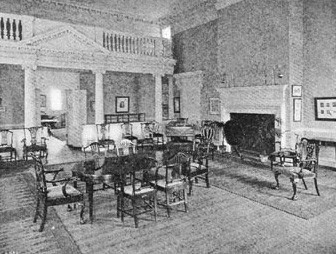
Photograph showing the “Senate Chamber” of the Maryland Building in the 1907 Tercentennial Exposition in Norfolk, Virginia, illustrated in Report of the Maryland Commission to the Jamestown Ter-Centennial Exposition (1908).
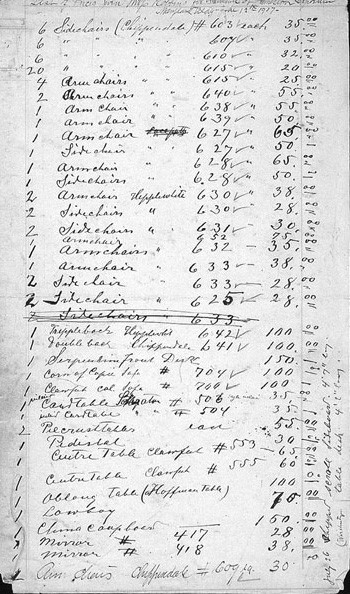
Inventory of objects loaned by Potthast Bros., Inc., for the Maryland Building in the 1907 Tercentennial Exposition in Norfolk, Virginia. (Courtesy, Potthast family collection.) The inventory is in Potthast letterbook, 1907.
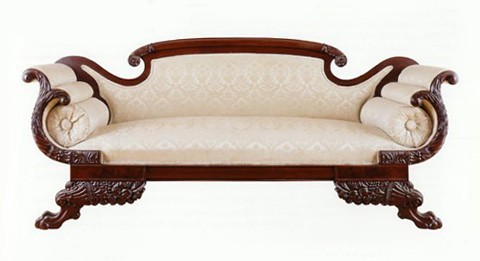
Potthast Bros., Inc., “Jamestown” sofa, Baltimore, Maryland, ca. 1906–1907. Mahogany with oak. H. 35 1/2", W. 79", D. 27 3/4". (Private collection; photo, Gavin Ashworth.)

Lithograph composite view of the Potthast shop at 702 North Howard Street and the Wicomico Street factory illustrated on the back cover of the firm’s brochure titled “The Dining Room Beautiful,” Baltimore, Maryland, ca. 1922. Potthast Bros., Inc., began to specialize in dining-room furniture by the mid-1920s. Advertisements and surviving objects suggest that tables, chairs, and sideboards constituted the bulk of the firm’s manufacturing work.
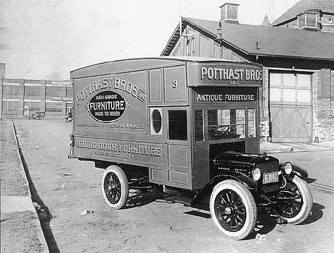
Photograph showing part of Potthast Bros., Inc.’s Wicomico Street factory with a delivery truck in the foreground, Baltimore, Maryland, ca. 1925. The vehicle is painted with a variety of slogans and catchwords including “Dining Room Furniture Our Specialty” and “Antique Furniture.”

Illustration from Potthast Bros., Inc., “Reproductions That Are An Investment,” Baltimore, Maryland, ca. 1930.
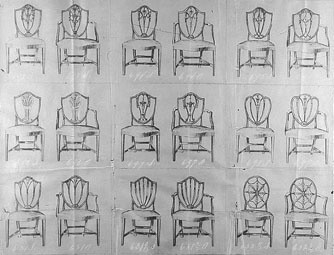
Potthast Bros., Inc., chair designs with identification numbers, Baltimore, Maryland, ca. 1910. (Courtesy, Potthast family collection.) This page of chair designs was found among a group of photographs and shop drawings. Such materials may have been used as a reference for both patrons and workmen.
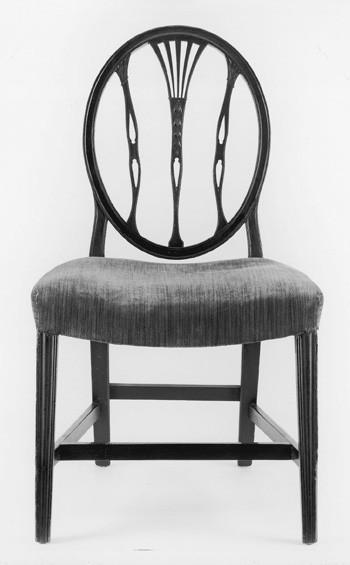
Side chair, Baltimore, Maryland, 1790–1810. Mahogany with tulip poplar. H. 37 1/4", W. 20 1/2", D. 16 3/4". (Private collection; photo, Gavin Ashworth.) This chair is part of a set originally owned by Charles Carroll of Homewood.

Potthast Bros., Inc., side chair, Baltimore, Maryland, ca. 1930. Mahogany with oak. H. 38", W. 20", D. 17". (Private collection; photo, Gavin Ashworth.)
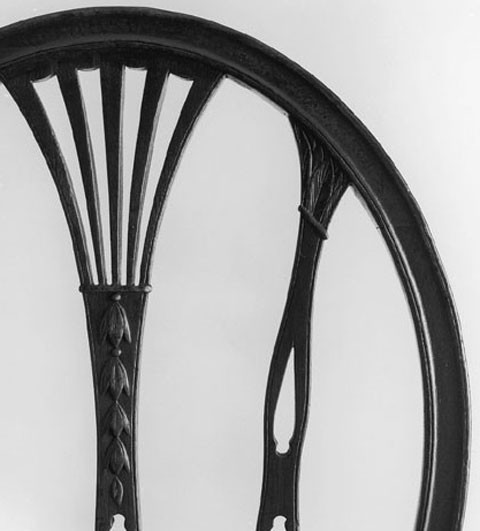
Detail of the carved husks on the back of the side chair illustrated in fig. 31. (Photo, Gavin Ashworth.)
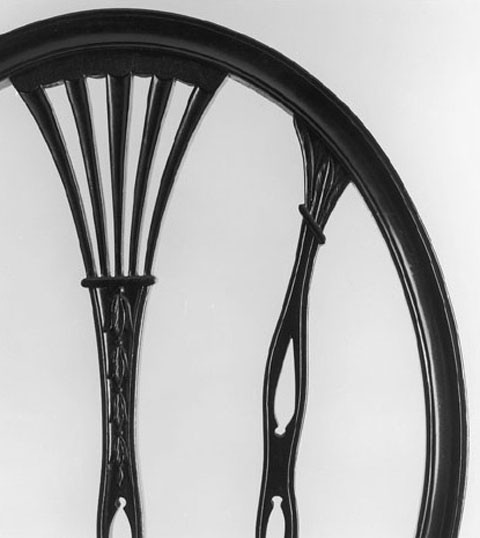
Detail of the carved husks on the back of the side chair illustrated in fig. 32. (Photo, Gavin Ashworth.)

Potthast Bros., Inc., label for “Authenticated Replicas.”
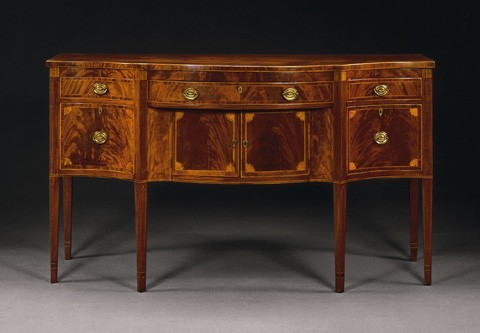
Sideboard, New York, 1790–1810. Mahogany with unrecorded secondary woods.
H. 41 1/2", W . 72 3/4", D. 28 3/4". (Courtesy, Christie’s.)
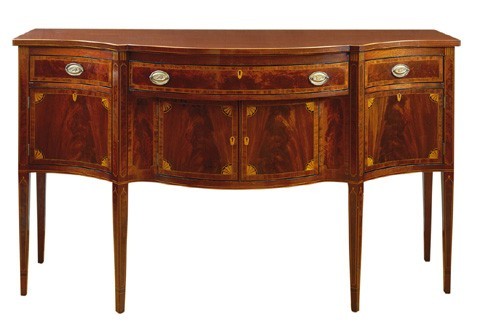
Potthast Bros., Inc., “Metropolitan” sideboard, Baltimore, Maryland, ca. 1940. Mahogany with oak. H. 40 1/2", W. 72", D. 24". (Private collection; photo, Gavin Ashworth.)

Photograph showing the “Metropolitan” window display at the Potthast Bros., Inc., store at 924 North Charles Street, Baltimore, Maryland, ca. 1930. (Potthast family collection; photo, Harry B. Leopold.)

Photograph showing the “Mount Vernon” window display at the Potthast Bros., Inc., store at 924 North Charles Street, Baltimore, Maryland, ca. 1930. This display may have been constructed in Febuary 1930 to commemorate Washington’s birthday. (Potthast family collection; photo, Harry B. Leopold.)
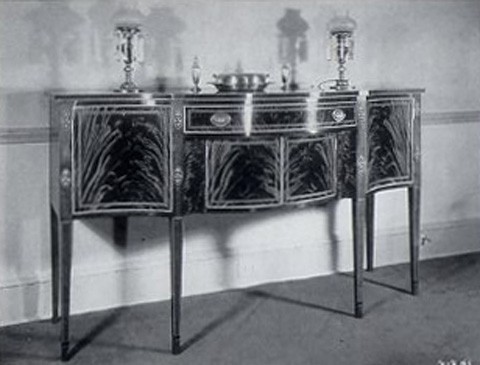
Potthast Bros., Inc., “Mount Vernon” sideboard, Baltimore, Maryland, ca. 1940. Mahogany and mahogany veneer with unidentified secondary woods. (Courtesy, Potthast family collection.)
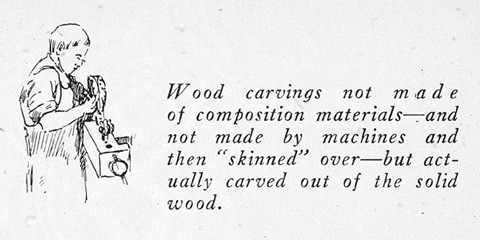
Drawing showing a chair leg being carved, in Potthast Bros., Inc., “Interesting Facts: Inside Secrets of Selecting Furniture Correctly,” Baltimore, Maryland, 1935.
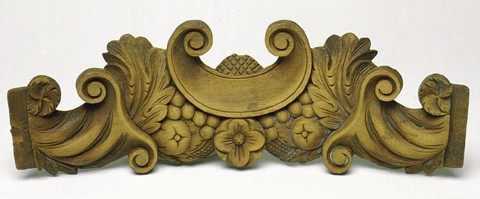
Potthast Bros., Inc., carved rail from an unfinished “Duncan Phyfe” chair, Baltimore, Maryland, ca. 1940. Mahogany. Dimensions not recorded. (Potthast family collection.)
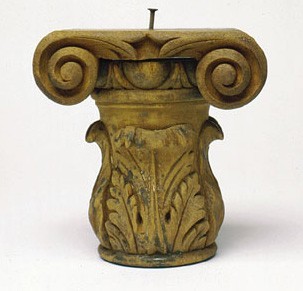
Potthast Bros., Inc., carved capital from an unfinished “colonial” chest of drawers, Baltimore, Maryland, ca. 1940. Mahogany. Dimensions not recorded. (Potthast family collection.)

Detail of a corner block and brands on the side chair illustrated in fig. 14. (Photo, Gavin Ashworth.)

Detail of a top fastener used by Potthast Bros., Inc. (Photo, Gavin Ashworth.)

Potthast Bros., Inc., dining table, Baltimore, Maryland, ca. 1930. Mahogany with tulip poplar and oak. H. 29 3/4", W. 60" (without extra leaves), D. 44 1/4". (Courtesy, Maryland Historical Society, Baltimore, Maryland.)

Detail of the inlay on a card table by Potthast Bros., Inc., Baltimore, Maryland, ca. 1930. (Courtesy, Maryland Historical Society, Baltimore, Maryland.)
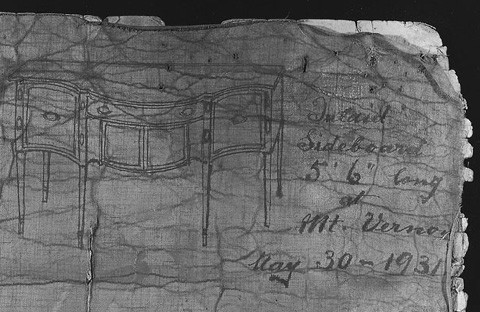
Potthast Bros., Inc., working drawings for the “Mount Vernon” sideboard, Baltimore, Maryland, 1931. (Courtesy, Potthast family collection.)
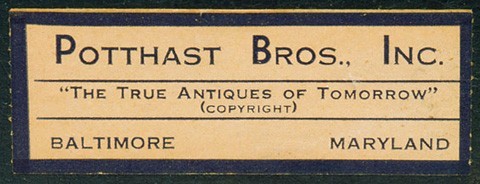
Potthast Bros., Inc., label, Baltimore, Maryland, 1930–1940.
The secret of making homes look beautifully furnished with unending charm . . . is not only cost, as many sometimes are inclined to believe. . . . It is a knowledge of furniture history, furniture making, and “where” to buy.
Potthast Brothers, Inc., “Interesting Facts: Inside Secrets of Selecting Furniture Correctly,” 1935
In 1892, four German immigrants—William, Vincent, John, and Theodore Potthast (fig. 1)—founded Potthast Brothers, Inc. (1892–1975), the most prolific cabinetmaking shop in late-nineteenth- and twentieth-century Baltimore. The firm’s copyrighted slogan, “The True Antiques of Tomorrow,” was not only prophetic but reflected the philosophy behind the Potthasts’ handmade reproduction furniture. Their desire to create furniture with intrinsic value affected the way the brothers and their workmen designed, manufactured, and marketed their products. Throughout its existence, Potthast Brothers was influenced by and has contributed to the popularity of the colonial revival style. The history and products of this firm shed light on twentieth-century interest in American antiques and the continuing popularity of reproductions.[1]
Potthast Brothers and Its Colonial Revival Context
Although the Potthasts’ high regard for handwork echoed ideals expressed in the arts and crafts movement, one of their early sales brochures noted that “the utter simplicity of the so-called ‘modern’ style does not call for . . . rare, artistic ability like that of the Old Masters whose art will last forever.” The brothers’ criticism of the arts and crafts movement probably had as much to do with self-image as with salesmanship. Just as neoclassical furniture embodied and embraced a wide vocabulary of symbols and motifs from classical antiquity, colonial revival furniture offered consumers a connection with America’s past. This was especially appealing to the Potthasts and other immigrants who sought to identify themselves with their new home. As historian Kenneth L. Ames has observed:
While an ethnically heterogeneous citizenry fostered America’s image as a land of prosperity open to all, it created significant social tensions, both among the older stock, which felt threatened on many levels by the newcomers themselves, the “uprooted,” who sometimes found social and cultural change excruciatingly difficult. Here the role of the colonial revival was to expedite acculturation and socialization.[2]
The colonial revival and its material culture satisfied the needs of native-born Americans who wished to maintain and assert their heritage and of immigrants who endeavored to be more like them. As Ames notes, both groups understood “the necessity of preserving relics in order to keep ideas and ideals alive.” Like Earnest F. Hagen, who restored and reproduced furniture made by New York cabinetmaker Duncan Phyfe and his contemporaries during the late nineteenth and early twentieth centuries, the Potthasts created a variety of “relics” with historical associations and connotations. With its conservative amalgam of established families and newcomers, Baltimore was the perfect location for their business. Like the Potthasts’ furniture, the colonial revival taste remained popular in the city throughout the twentieth century.[3]
Hundreds of pieces of Potthast furniture are known, most of which reside in private collections and museums in the Baltimore-Washington area. The work is usually branded or labeled because the Potthasts considered their name synonymous with quality and “authenticity.” A tremendous amount of documentary material relating to the firm also survives. The Maryland Historical Society has fifty glass plate negatives taken by John Potthast, five books containing correspondence with customers and suppliers, and approximately four hundred shop drawings. Additional papers and photographs are in the possession of Potthast descendants. A large group of images, most taken by Harry B. Leopold (1891–1977) of Baltimore, includes views of window displays, retail salesrooms, and individual pieces of furniture produced by the firm. These photographs were assembled as a sample book to show prospective clients examples of work done by the firm.[4]
Sales literature published by the Potthasts documents many of the sources they consulted and provides information on the firm’s marketing strategies. Their brochures typically cite early-twentieth-century furniture histories in conjunction with eighteenth- and early-nineteenth-century design books, but make no distinction between primary and secondary sources. Although their ultimate goal was to boost sales, the Potthasts understood the importance of teaching potential patrons about period styles, design, and craftsmanship. They believed that educated consumers would be more likely to consider handmade reproductions superior to mass-produced furniture. By assuming the role of “mentor,” the Potthasts positioned themselves as arbiters of taste to their well-established, predominately upper-class clientele.[5]
The ability to recognize period styles was important to collectors who sought to formulate and express their own notions of good taste. During the 1930s, the Potthasts published several individual brochures devoted to different furniture styles, most of which were associated with English monarchs and British and American cabinetmakers and designers. The terms used to describe these styles parallel those found in early-twentieth-century periodicals and furniture anthologies: “Queen Anne,” “Chippendale,” “Sheraton,” “Hepplewhite,” “Robert and J. Adam,” and “Duncan Phyfe.” The dates assigned to these styles correspond to monarchial reigns (“Queen Anne, 1702–1714”) and the life dates of designers and furniture makers (“Chippendale, 1705–1779”) rather than to their original period of popularity. Like many of their contemporaries, the Potthasts used the term “colonial” (fig. 2) in the broadest possible sense. In The Quest of the Colonial (1906), Robert and Elizabeth Shackleton noted that “‘colonial’ is attached to all the furniture of the early times and the early shapes. It has come to be so generally employed, and is a term in itself so suggestive . . . that it would be invidious . . . to limit its use with chilly literalness.” During the early twentieth century, the term “colonial” was most often used to describe what modern scholars call “empire revival,” the latest of the revival styles, rather than the earliest as one might expect.[6]
Fortunately for the Potthasts, a national interest in American antique furniture spurred demand for reproductions. Such books as Irving Whitehall Lyon’s The Colonial Furniture of New England (1891), Esther Singleton’s The Furniture of Our Forefathers (1901), and Wallace Nutting’s Furniture Treasury (1928) guided both collectors and individuals interested in decorating their homes. Women’s magazines frequently included articles on antiques and decorating, and a variety of books and periodicals advocated the purchase of reproductions for those unable to afford period furniture. The magazine Antiques (1922 to the present), which was one of the most important vehicles for the dissemination of the “colonial” taste, regularly featured advertisements by colonial revival furniture manufacturers.
In 1915, the nation’s “first interior decorator,” Elsie de Wolfe (1865–1950) published The House in Good Taste, which remained influential for decades. She devoted an entire chapter to reproductions of antique furniture and objects of art, and asserted that unless one was a collector of rare antiques, reproductions were preferable for everyday comfort and use:
No one can swear to a piece of furniture having been made in the workshops of the Chippendales. Even the pieces in the Metropolitan Museum are marked “Chippendale Style” or “In the Sheraton Manner”. . . . If the furniture is in the style of these makers, and if it is really old, you will pay a small fortune for it. . . . Why then lend yourself to possible deception? Why pay for names when museums are unable to buy them? If your object is to furnish your home suitably, what need have you of antiques? The serious amateur will fight shy of miracles. If he admires the beauty of line of a fine old Hepplewhite bed or Sheraton sideboard, he will have reproductions made by an expert cabinetmaker. The new piece will not have the soft darkness of the old, but the owner will be planning that soft darkness for his grandchildren, and in the meantime he will have a beautiful thing to live with.
Letterbooks and account books maintained by the Potthasts reveal that Elsie de Wolfe was a regular client of their firm. It is quite possible that Potthast Brothers, Inc., was the “expert cabinetmaker” she alluded to in her book.[7]
A sketch of an “Adam style” chair in the firm’s 1907 letterbook (fig. 3) is inscribed “Miss de Wolfe.” Although it is impossible to determine if examples were made for her or for one of her clients, the sketch may have been the basis for a dining-room suite subsequently made for Pleasant Hill (built in 1917), the home of C. Wilbur and Edith (Davison) Miller of Baltimore. This suite consists of a dining table with five leaves, a large sideboard with a pair of matching knife urns, a huntboard, two breakfront silver cabinets, twenty-two side chairs, two armchairs, and an oversize “huntmaster’s chair” (figs. 4, 5). Baltimore architect James Edmunds designed Pleasant Hill. The original plans survive along with a series of photographs of the completed interiors, two of which show the Potthast suite in situ (fig. 6).[8]
The Origins and Development of the Potthast Firm
In 1891, two of six Potthast brothers left their home and family cabinetmaking business in Borgholtz, Germany, to immigrate to America. William Potthast (1862–1935) (fig. 7) and his younger brother Vincent (1866–1911) (fig. 8) arrived in Baltimore and found employment as cabinetmakers for the William Knabe and Company Piano Forte factory at the corner of Eutaw and West Streets. While working for Knabe and Company, William and Vincent spent evenings and weekends buying and restoring antique furniture. By 1892 they had acquired enough furniture to open an antique shop at 321 North Howard Street. Shortly thereafter, John (1870–1962) and Theodore Potthast (1875–1966) arrived in Baltimore to join their brothers’ business. Several antique dealers were already located in the vicinity. The Baltimore City Directory listed one furniture dealer specializing in antiques in 1886 and eighteen antique dealers in 1900. Twelve of the eighteen dealers maintained shops on North Howard Street, the current site of Baltimore’s “Antiques Row.”[9]
The Potthasts moved to larger quarters at 507 North Howard Street in 1899 (fig. 9). Four years later they relocated their restoration business to 506–508 Tyson Street and began using the Howard Street building as a showroom. In 1905, the German-language newspaper Das Neue Baltimore reported that Potthast Brothers was where “high society meets, when it is seeking original art furniture or truly antique wares.” The earliest labels used by the firm give both addresses and read “POTTHAST BROS./ DEALERS IN/ ANITQUE FURNITURE/ and/ ARTISTIC FURNITURE MFRS.” As their label suggests, the Potthasts began by selling and restoring antiques, but quickly moved into designing and manufacturing furniture. [10]
A chest of drawers (fig. 10) attributed to Baltimore cabinetmaker William Camp (fl. 1801–1822) is one of several locally made antiques repaired by the Potthasts. Evidence of their work can be found in the thick varnish that covers the case, drawer sides, and drawer interiors. In typical fashion, the brothers placed labels on the chest (fig. 11), one on the back of the case, and one on each of two drawer bottoms. A sketch of a similar chest (fig. 12) is included in a 1907 letter from the Potthasts to a customer in Massachusetts:
We are sending herewith a rough sketch of an old chest of drawers which we have on hand in the rough & which we can put in order for thirty-five . . . dollars including crating. If this sketch should not be satisfactory, we could send others of pieces we have on hand for forty or forty-five dollars.[11]
One of the Potthasts’ most important patrons was Baltimore physician William H. Crim (1845–1902). His antique collection, which was one of the earliest assembled in America, sold at auction in Baltimore in April 1903 (fig. 13). The sale featured 2,841 lots and realized over seventy thousand dollars. This event was extremely important to the Potthasts because they had restored many of the pieces for Crim. As a result of their work, the craftsmen had become familiar with the design and construction of his furniture. They had also measured and drawn several pieces in his collection in order to make reproductions. This proved to be advantageous for the Potthasts, since the notoriety of the sale and its record-setting prices created a strong market for copies of Crim’s furniture.[12]
In response to this demand, or possibly in anticipation of it, the Potthasts made reproductions of several items in the sale catalogue. These reproductions immediately became best-sellers and were frequently illustrated in brochures published by the firm. The Potthast side chair shown in figure 14 is based on a “Magnificent Rare Old Mahogany Ball and Claw Foot Chippendale Chair” described as “one of the finest in the [Crim] collection” (fig. 15). Made in Philadelphia about 1750, the antique sold for three hundred dollars, a remarkable sum in 1903. A brochure published by the Potthasts cites both the sale and the hammer prices, which stood in stark contrast to the price of the reproduction (fig. 16). The “Crim chair,” as it was known, continued as the Potthasts’ best-selling model and remains desirable today.[13]
Although the Potthasts succeeded in replicating the basic form of the Crim chair, they were unable to duplicate the carving. The acanthus leaves on the knees and back of the reproduction are crude in comparison with those on the original (figs. 17, 19), which are attributed to an anonymous Philadelphia tradesman referred to today as the “Garvan carver.” The claw-and-ball feet on the Potthast chair also have large knuckles and thick webbing like those on many other chairs made in the colonial revival style.
Eight “fine armchairs” that reputedly belonged to Maryland attorney Francis Scott Key (fig. 20) inspired another Potthast reproduction (fig. 21). The original set, which sold for eight thousand dollars in the Crim sale, was catalogued as “one of the handsomest and most delicately carved [seating forms] . . . ever created by Chippendale.” Although the Potthasts may have given some credence to this provenance, they realized that there was no basis for attributing them to Chippendale and refrained from mentioning the designer in advertisements and sales literature for the reproduction chairs. The “Key chairs” were especially popular with local patrons, owing to their association with the lyricist of the “Star-Spangled Banner.”[14]
The Jamestown Tercentennial Exposition held in Norfolk, Virginia, in 1907 allowed the Potthasts to display their “artistic furniture” before a national audience. Twenty-one states participated by constructing state buildings to honor their respective histories, modern day industries, and commerce. The General Assembly of Maryland appointed twenty-five commissioners and an auxiliary board of five women and appropriated sixty-five thousand dollars for a Maryland Building. After rejecting a proposal to construct a replica of the state house in Annapolis, the commission selected the plan of architect Douglas H. Thomas, Jr., to build a version of Homewood, the country house of Charles Carroll, Jr. (fig. 22). In this modified replica, Thomas substituted the senate chamber of the Maryland State House (figs. 23, 24) for the principal first story room. The Potthasts lent furniture for the building, realizing that it would generate interest in their firm and add prestige to their reproductions. A report published by the commission in Baltimore in 1908 documented every aspect of the project and included photographs of the interiors and comments on the furnishings:
It was the purpose of the Commission to furnish the Maryland Building so far as it was possible with colonial furniture. . . . The Commission was very fortunate in enlisting the cooperation of the Potthast Brothers of Baltimore who from the very first showed every desire to contribute all they could for the benefit of the State. They loaned . . . free of charge, sixty-two chairs, five tables, four sofas, a mahogany low-boy, two mahogany and gilt mirrors, a mahogany cabinet, a mahogany table, an inlaid side table, a mahogany desk and a mahogany stand, all these pieces being of large size and extremely handsome. They formed the main part of the furnishing . . . and gave the whole interior a dignity and a solid elegance which elicited cordial tributes from thousands of visitors . . . There has been quite a revival of the eighteenth century styles and the extraordinary popularity of such original pieces as are extant has caused this colonial furniture to be much copied. The furniture of Messrs. Potthast Brothers had therefore an interest far beyond its historical value because of its practical relations to the home furniture of the present day.
The participation of the Potthasts is further documented by interior views of the building; the firm’s inventory of loans (fig. 25); correspondence detailing the selection of upholstery fabrics, crating, and shipping; and a letter offering the loaned objects for sale to Tiffany Studios at the close of the exposition.[15]
Several antiques were also exhibited in the Maryland Building. The Potthasts lent a sideboard that descended in the Key family; Mrs. John Ridgely, a member of the women’s auxiliary commission, lent a “colonial table” from Hampton; and William Knabe and Company lent a harpsichord formerly owned by Charles Carroll of Carrollton. The table, harpsichord, and a variety of reproductions loaned by the Potthasts are visible in photographs of the “Senate Chamber” (figs. 23 , 24). At least thirteen of the firm’s chair designs are documented in these images and the loan inventory. Potthast Brothers, Inc., did not provide all the furnishings for the Maryland Building, however. A report by the commission also includes photographs of other rooms, such as the “Reading Room,” which show reproductions made by the Potthasts along with Mission-style furniture made by students from the Maryland Manual Training Schools and School for Boys.[16]
Although the Potthasts loaned seventy-nine reproductions to the Tercentennial Exposition, only two sofas (fig. 26) can be linked definitively with the Maryland exhibit. These objects do not appear in any of the photographs, but they are mentioned in the loan inventory (fig. 25) and both descended in the Potthast family. The upholstery fabrics selected for the sofas and other seating forms loaned by Potthast Brothers are described in an April 1907 letter from the firm to Mrs. Henry Rogers.[17]
The Potthasts’ correspondence during the period of the Tercentennial Exposition is replete with references to furniture on display in the Maryland Building. This exhibit was one of the first to open, and the firm received many inquiries regarding the prices of items they had loaned. As the exposition drew to a close, the Potthasts endeavored to sell the furniture as a single lot, possibly because they lacked the space to display the pieces in their Baltimore showroom. On October 5, 1907, they wrote Tiffany Studios:
We have in the Maryland Building of the Jamestown Exposition a lot of our hand-made furniture which at retail prices is valued at $3430; it consists of 49 side chairs, 17 arm chairs, 8 tables, 4 sofas, 1 china press, 1 sideboard, and 2 mirrors—They are all first class pieces in every respect. We will sell the entire lot crated, f.o.b. at Norfolk for $2400.00. We could make arrangements with the . . . Commission to put a sign in the Maryland Building stating by whom the furniture was purchased if desired as an ad.
Three days later they sent another letter along with photographs, sketches, and a list of retail prices. “You will see by the photos that this is entirely different from the furniture of similar styles which you find in the market,” wrote the Potthasts. “We hope you will give this matter careful consideration and let us hear from you as soon as possible.” A final letter sent on October 19, 1907, states, “[W]e are anxious to hear from you regarding the furniture at the Maryland State Bldg. . . . The fair is nearing a close & we would like to have time to dispose of these goods to some other purchaser if you do not require them. If you will figure the prices up on these goods piece by piece, you will find them below cost of their manufacture.” There is no evidence that Tiffany Studios purchased any of this furniture, even though they did considerable business with the Potthasts. The financial panic of 1907 may explain Tiffany Studios’ lack of interest as well as the Potthasts’ desire to liquidate the furnishings in the Maryland Building. Other correspondence in the 1907 letterbook reveals that the firm made a concerted effort to collect debts on outstanding accounts to improve cash flow.[18]
In spite of this brief economic downturn, Potthast Brothers flourished. The firm grew, moving into new quarters at 702 North Howard Street in 1914. The next expansion occurred in 1921, after the brothers purchased land in southwest Baltimore and erected a large factory at 1438 Wicomico Street. A composite view from 1921 or 1922 (fig. 27) shows both the 702 North Howard Street store and the 1438 Wicomico Street factory (fig. 28). Visible in the background of the lithograph are the lumberyard and smokestack for the drying kiln. The factory expanded again in 1925, when the Potthasts moved their showroom to its final location at 920 (later renumbered to 924) North Charles Street. In the mid-1930s, Potthast Brothers purchased 926 North Charles Street and had showrooms in the adjoining buildings. The firm sold the 926 North Charles Street location in the mid-1940s, and the building was destroyed.[19]
A second generation of Potthasts entered the family business during the 1920s and 1930s. Six of the founders’ sons served apprenticeships in addition to studying architectural drawing at the Maryland Institute College of Art in Baltimore. Although Vincent Potthast had three sons, none appear to have joined the firm. William’s sons, Frank J. (1894–1942) and George J. (1895–1988), held important positions by 1938, the former serving as secretary-treasurer and the latter as general manager of the cabinet shops. John Potthast, Sr., was president and his sons, William A. (1902–1971) and Theodore J. (1905–1998), were the assistant secretary-treasurer and manager of the shops, respectively. Theodore Potthast, Sr., was vice-president; his son Michael Potthast (1911–1973) was office manager; and his other son Berthold (b. 1913) was assistant manager in the shops. All of these positions were based on seniority, skill, and interest.[20]
Potthast Brothers manufactured enormous quantities of furniture during the 1940s and 1950s, both for local patrons and for consumers in more distant locales. During World War II, the firm also completed various defense work projects for the U.S. Government. After the war, the Potthasts trained veterans as part of a special government project.[21]
Because of the firm’s renown, Potthast Brothers received many important commissions. They made dining room suites for movie producer Cecil B. de Mille and for President Woodrow Wilson upon his departure from the White House. They also made furniture for the Catholic archbishop’s residence in Baltimore and the Governor’s Mansion in Annapolis, Maryland.[22]
The second generation of Potthasts reached retirement age in the 1970s. With the death of William Potthast in 1971 and the retirement of George Potthast shortly thereafter, Theodore J. Potthast, Sr., was the sole family member remaining in the business. Although the market for the firm’s furniture continued to be strong, the Potthast family dissolved the business in 1975. At that time the firm had thirty-five employees. The inventory sold quickly after the closure was announced. The factory and equipment were auctioned and the building was sold and converted to the Brass Elephant restaurant. The interior remains virtually unchanged from its appearance during Potthast Brothers’ occupancy.[23]
The Influence of Auctions and Private Collections on Potthast Furniture
Auctions such as the Crim sale were an important influence on the Potthasts and their contemporaries who also produced colonial revival furniture. Auction catalogues were excellent design sources, and sales results helped the Potthasts gauge demand for different furniture styles and forms. Several highly publicized auctions occurred during the early twentieth century, including Colonial Furniture: The Superb Collection of the Late Howard Reifsnyder (1929) and The Philip Flayderman Collection: Historic American Furniture (1930). Both sales brought record prices owing to the popularity of American antiques and competition among collectors such as Henry Ford, Francis Garvan, and Henry Francis du Pont.[24]
Pieces commanding unusually high prices were a carved Philadelphia easy chair attributed to Benjamin Randolph (now in the Philadelphia Museum of Art) that brought thirty-three thousand dollars in the Reifsnyder sale and a labeled John Seymour tambour desk (now in the Winterthur Museum) that fetched thirty thousand dollars in the Flayderman sale. Potthast Brothers made reproductions of both pieces and used them as illustrations in sales brochures (fig. 29), including one titled “Reproductions That Are An Investment” (ca. 1930). They also reproduced other forms from the Reifsnyder and Flayderman sales and noted that individuals without the means to collect antiques could achieve the same look for “a fraction of the cost.” Another brochure, titled “Replicas from Collectors’ Antiques,” points out the difficulty in collecting period furniture and offers a predictable solution:
Often one may search in vain to find the desirable piece or pieces of furniture that they [sic]would like to enjoy in their home. Many likewise . . . have visited museums, historical shrines which offer their contribution for furnishing the home in authentic good taste, but have not found their wishes realized. . . . The thoughtful home furnisher making a choice from these authoritative books—connoisseur’s collections, and having them reproduced by Potthast’s hand-methods, individually-made, like the original antiques, can never err in good judgment for excellent taste, for beauty, and for enhancing in value with Potthast’s signature and Coat of Arms as, “The True Antiques of Tomorrow.” [25]
Several auction catalogues and furniture anthologies owned by Potthast Brothers are annotated. These notations help document the forms the firm copied or adapted to produce such novelties as “Queen Anne” sideboards, “Chippendale” coffee tables, and “Hepplewhite” telephone stands. The Potthasts were undoubtedly familiar with the works of British designers such as Chippendale and Hepplewhite. A page of chair designs produced by the firm is reminiscent of engravings in eighteenth- and nineteenth-century pattern books (fig. 30).[26]
Furniture in local collections was another source of inspiration for the Potthasts. Their shop copy of Baltimore furniture historian Edgar G. Miller’s American Antique Furniture: A Book for Amateurs (1937) has notations regarding pieces that the firm either copied or repaired. Most of the individuals who allowed Miller to illustrate objects in their collection were from Maryland and many were direct descendants of the original owners.[27]
One of the Potthasts’ most successful reproductions was based on a pair of oval-back chairs (fig. 31) reputedly commissioned by Charles Carroll of Carrollton, one of four Maryland signers of the Declaration of Independence. In 1801 Carroll built and furnished Homewood as a wedding present for his son Charles and daughter-in-law Harriet (Chew) of Philadelphia. Given the date and provenance of the chairs, it is likely that they were part of the original furnishings of the house. No other Carroll family houses were being built or furnished during this period. These chairs probably sat in the dining room and were part of a set of ten or twelve. At least two other examples are owned by other Carroll family descendants.[28]
In the early twentieth century Mrs. Mary-Lee Carroll Muth owned the chair illustrated in figure 31. During the 1930s, she commissioned Potthast Brothers to repair her pair and make additional examples (fig. 32) for use in her dining room. Shortly thereafter, the firm began selling a virtually identical model described as a “Hepplewhite oval back chair, originally owned by Charles Carroll of Carrollton—Signer of the Declaration.” One brochure boasted that “the amazing perfection of joinery, carvings, inlaying and finish” attained by Potthast craftsmen often caused the firm’s reproductions to be mistaken for the original antiques. Although the chairs made to expand Mrs. Muth’s set are similar to the originals, there are slight differences in the shape of the oval, angle of the back, arrangement and position of the stretchers, and outline of the carved husks (figs. 33, 34). From a distance, however, the Potthast chairs are difficult to spot.[29]
Potthast Brothers also made reproductions for several museums and historical organizations that were attempting to create room settings. Their institutional patrons included Continental Memorial Hall, the Museum of the Daughters of the American Revolution, and the Hammond-Harwood House. Many of the reproductions made for these organizations subsequently became part of the Potthasts’ line. As in the case of the Carroll chairs, the firm used historical and institutional connections to promote their products.[30]
According to Theodore J. Potthast, a member of the second generation, most museums allowed their members to copy objects in their collection prior to the advent of licensing agreements. The firm’s craftsmen would travel to a museum, make sketches, and, when no guards were present, they would take measurements. Theodore noted that he, his brother, and his cousins were adept at technical drawing owing to their training at the Maryland Institute College of Art. In September 1938 the Baltimore Magazine reported:
Once [Potthast Brothers] received [an order] for something . . . not previously made—the initial step is for meticulously correct drawings to be made, together with minute descriptions of the wood and other necessary details. As an aid to securing such information, the company holds memberships in a number of the larger museums in this country.
The Potthasts described their institutional reproductions as “authenticated replicas,” and about 1930 they began identifying them with a label (fig. 35). They also published a series of brochures, printed on an in-house press, devoted to the Metropolitan Museum of Art, Mount Vernon, Greenfield Village, the Philadelphia Museum of Art, and Colonial Williamsburg. Other museums and historic houses mentioned in general sales literature include the Brooklyn Museum; the Museum of Fine Arts, Boston; the Baltimore Museum of Art; the Minneapolis Museum of Art; the Cleveland Museum of Art; Dumbarton House; the Hammond-Harwood House; the Peggy Stewart House; the Brice House; Homewood; Mount Clare; Monticello; and Kenmore. [31]
Based on an example formerly in the Metropolitan Museum of Art (fig. 36), the sideboard illustrated in figure 37 was one of the Potthasts’ most ambitious institutional reproductions. This model invariably has beautifully figured mahogany veneer and fine inlay work. A brochure published soon after the firm introduced the reproduction encouraged their customers to visit the museum and noted that “it stands without peerage among the exhibition places of the earth . . . no other American institution . . . affords such charming demonstrations of home styles as shown in the American Wing.” A window display at the firm’s 924 North Charles Street location (fig. 38) was devoted to reproductions of pieces from the Metropolitan’s collection and includes an example of this sideboard.[32]
A similar brochure capitalized on the allure of George Washington’s home, Mount Vernon, arguably the most important “shrine” of the colonial revival:
George Washington, noted for his military qualities and his statesmanship, at Mount Vernon demonstrated his ability as a homemaker. He possessed discriminating taste in both [the] interior and exterior treatment of his home and, no doubt, was greatly assisted by his wife, Martha.
In this clever promotional piece, “discriminating taste” and “statesmanship” are given nearly equal billing. By purchasing reproductions from Potthast Brothers, modern consumers could identify themselves with George and Martha and the patriotic sentiments they and their home invoked. A window display at 924 North Charles Street (fig. 39) featured several reproductions derived from Mount Vernon furniture, the most notable of which was a sideboard like the example shown in figure 40. The “Mount Vernon” sideboard was second only to the “Metropolitan” example in design and popularity.[33]
Construction Techniques and the Identification of Potthast Furniture
In addition to associating their work with objects in important auctions, private and public collections, and the homes of historical figures, the Potthasts used craftsmanship as a selling point for their furniture. They referred to their products as “individually hand-made” and used slogans proclaiming “the charm of . . . hand-made furniture.” By contrast, most colonial revival furniture was mass-produced by large firms in Chicago, Illinois, Grand Rapids, Michigan, and other modern furniture centers. In these factories, which often employed as many as five hundred workers, mechanization was critical to cutting costs since these firms supplied the mail-order giants Sears Roebuck and Montgomery Ward, as well as smaller department stores across the country. Typical features of mass-produced furniture are doweled joints, machine-cut dovetails with rounded pins and tails, applied spindle or embossed “carving,” and inlay decals.
Although the Potthasts used machinery and power tools, they described their firm as a “medium-size hand shop.” In a brochure titled “Interesting Facts: Inside Secrets of Selecting Furniture Correctly,” they claimed:
Factory mass-made counterfeits . . . are lacking in distinction, values, and true charm. The reason [they] . . . will never . . . approach the inherent beauties of the great masterpieces is because the former are built in large quantities by machine methods. The genuine reproductions when made after the methods of the Old Masters are . . . INDIVIDUALLY MADE with infinite pains by an artistic craftsman . . . [and] will result in a rich piece that . . . becomes a masterpiece! When made in the Potthast shops, it will live forever as, “The True Antiques of Tomorrow” becoming as famous and its value apt to increase as much as those made by the Old Masters.
The Potthasts’ brochures also advised consumers to avoid the work of “small shops,” whose owners lacked “real knowledge of furniture designing,” were “prone to clumsy proportions,” executed “details poorly,” and produced “crude carvings and poor workmanship.” These remarks were probably designed to ward off competition from two local firms—J. W. Berry & Son (fl. 1899–1987), which specialized in the sale and repair of antique furniture, and Enrico Liberti (fl. 1930–1977), the proprietor of Chimney Corner Antiques. Liberti, who was born and trained in Italy, immigrated to Baltimore in 1920 and worked for Knabe Piano Company before opening his own shop in 1930. Contrary to the Potthasts’ claim, the Berry and Liberti shops both produced good reproductions using traditional craft methods and excellent materials. [34]
A “medium-size shop” like the Potthasts’ typically employed ten to forty craftsmen who specialized in different aspects of production. The firm’s use of the phrase “hand-made” did not exclude the use of power tools; rather it meant that machine-cut components were assembled, carved, and finished by hand. “Interesting Facts” illustrates and describes a variety of construction and carving techniques employed by Potthast Brothers and contrasts them with mass-production methods (fig. 41). The Potthasts noted that their carving was executed “in solid wood” rather than “composition materials ‘skinned over’ by machines.” Details of a reproduction “Duncan Phyfe” chair (fig. 42) and a “colonial” chest of drawers (fig. 43) illustrate the quality of their work.[35]
Although the Potthasts used a variety of traditional construction methods including handcut dovetails, mortise-and-tenon joints, and fully paneled backs, they also employed some modern techniques. The firm’s craftsmen cut, planed, and shaped their stock on machines, attached corner blocks with screws (fig. 44), and secured the tops of tables (fig. 45), sideboards, and chests of drawers with metal fasteners. Because these fasteners “floated” in grooves, they allowed the top to expand and contract without splitting. Modern improvements of this type were acceptable provided they did not affect the outward appearance or accuracy of “authentic reproductions.” As the mahogany “Hepplewhite” dining table illustrated in figure 46 reveals, however, the firm did not limit itself to replicas. This model, which appears in “Interesting Facts,” was adapted from “a pair of end tables” and made to accommodate additional leaves. [36]
The woods used by Potthast Brothers were carefully selected for quality and figure and seasoned in a drying kiln at the factory. They purchased pulls, escutcheons, and other brass mounts from Faneuil Hall Hardware in Boston and inlay from Dover Inlay of New York. Many of the inlays were stock items, but some were custom-made. The paterae and husk designs shown in figure 47 are simplified versions of late-eighteenth- and early-nineteenth-century Baltimore inlays. The husks hang from an elliptical dot rather than an open ring and the petals are not shaded as strongly as those on period examples.[37]
During the construction process, Potthast craftsmen worked from full-scale drawings. The earliest drafts are on standard roller-type window shades (fig. 48), which were more durable than later paper ones. Their drawing for the “Mount Vernon” sideboard is color-coded and shows all of the joinery details. The Potthasts’ workmen undoubtedly used such drafts as templates as well as reference points for laying out joints and other details.
Many of the pieces made by Potthast Brothers are marked with labels, brands, or a combination of the two. The firm’s printed address or slogan “The True Antiques of Tomorrow” (fig. 49), which the Potthasts adopted after 1931, provides a rough chronology for their labels. Furniture made after 1910 is often branded, although labels continued in use. The firm used two brands, one simply the name “potthast” in block letters, the other a more elaborate oval mark (see figs. 44, 45). Case pieces usually have labels or brands on a backboard or on the interior of a drawer side, whereas tables, chairs, and sofas are frequently marked on the interior of the frame or on the inner surface of a leg. One antique sideboard, probably repaired by the firm, has the inscription “Potthast” penciled on the underside of its center drawer. The Potthasts also marked pieces made for family members. These objects include “authentic reproductions,” adaptations, and items that were not part of their product line—jewelry boxes, mantle clocks, wall brackets, floor lamps, picture frames, and crucifixes. The last were typically made as presents for holidays and birthdays or to commemorate anniversaries and other special events.
“The True Antiques of Tomorrow”
The presence of Potthast furniture in such notable collections as those of the Maryland Historical Society, the Baltimore Museum of Art, and the Smithsonian Institution attests to the firm’s success and its role in the development and promotion of the colonial revival style. When the Maryland Historical Society moved its headquarters into the Pratt-Keyser Building in 1919, the organization hired the Potthasts to make two large library bookcases with glazed doors. The bookcases were installed in the Keyser Building, which was added to the Enoch Pratt House (1846–48) in 1919. Sixty years later the society acquired a large group of Potthast furniture including a sideboard, dining table, card table, and chairs in recognition of the firm’s contribution to the colonial revival and the history of cabinetmaking in Baltimore. It is in this and other institutional venues that the Potthasts’ slogan “The True Antiques of Tomorrow” is ultimately validated.[38]
ACKNOWLEDGMENTS
The author is deeply grateful to the Potthast family, especially the late Theodore J. Potthast and his widow, Marie Corcoran Potthast, for sharing their documentary materials, personal accounts, and memories. For inspiration and encouragement beyond the scope of this article, the author thanks Gregory R. Weidman.
Potthast Bros., Inc., patented the slogan “The True Antiques of Tomorrow” (no. 13082) on March 10, 1931. Potthast Bros., Inc., “Interesting Facts: Inside Secrets of Selecting Furniture Correctly,” 1935, p. 21; collection of author.
Interest in preindustrial craft methods and indigenous styles was at the core of the arts and crafts movement and of the Potthasts’ philosophy. Several prominent craftsmen, including L. & J. G. Stickley, made reproductions of antique furniture before turning to the Mission style. See Wendy Kaplan, “The Art That Is Life”: The Arts & Crafts Movement in America, 1875–1920 (Boston: Museum of Fine Arts, Boston, 1987), for more on the relationship between the arts and crafts movement and the colonial revival. Potthast Bros., Inc., “Interesting Facts,” p. 21. Although the Potthast brothers married other German-Americans and maintained social connections within Baltimore’s large German-born population, the furniture produced and sold by their firm was thoroughly American in design. William B. Rhoads, “The Colonial Revival and the Americanization of Immigrants,” in The Colonial Revival in America, edited by Alan Axelrod (New York: W. W. Norton, 1985). Kenneth L. Ames, “Introduction,” in ibid., pp. 13–14.
Ames, “Introduction,” pp. 13–14. For more on Hagen, see Deborah Dependall Waters, “Is It Phyfe?” in American Furniture, edited by Luke Beckerdite (Hanover, N.H.: University Press of New England for the Chipstone Foundation, 1996), pp. 63–81.
Letterbook 1: 1908–9, letterbook 2: 1914–17, letterbook 3: 1919, letterbook 4: 1920–21, letterbook 5: 1926–32, ms2183, library collection, Maryland Historical Society, Baltimore. Additional correspondence is in ms 2659. Harry B. Leopold (1891–1977) worked as a news photographer for the Baltimore Sun and the now defunct News American. He also operated a commercial photography business. Leopold’s work illustrates many Baltimore buildings and businesses. His obituary was published in the July 22, 1977, issue of the Baltimore Sun. Sample book of photographs, Potthast family collection.
One brochure titled “Replicas from Collectors’ Antiques” (ca. 1930) serves as a virtual bibliography for the firm’s sales literature. It cites Thomas Chippendale’s The Gentleman and Cabinet-Maker’s Director (1754), George Hepplewhite’s The Cabinet-Maker and Upholsterer’s Guide (1788), Thomas Sheraton’s The Cabinet-Maker & Upholsterer’s Drawing Book (1793), and the Society of Upholsterer’s The London Cabinet-Maker’s Book of Prices (1788). This brochure also states that “[in addition to museums] there is . . . another genuine source of much reliable information that is available through distinguished authorities—writers of furniture history with many illustrations in their books.”
Additional references include “Sheraton, 1751–1806,” and “Hepplewhite, 1780 a.d.” Robert and Elizabeth Shackleton, The Quest of the Colonial, 3d ed. (1906; reprint ed., New York: Century Co., 1921).
Jane S. Smith, Elsie de Wolfe: A Life in the High Style (New York: Atheneum, 1982). Elsie de Wolfe, The House in Good Taste (New York: Century Co., 1915), pp. 260–61.
Letterbook, 1907, p. 305, Potthast family collection. Mrs. Barbara White interviews with the author, Baltimore, Maryland, spring 1999. Mrs. White was the granddaughter-in-law of C. Wilbur and Edith Miller. No records supporting a business relationship between Edmunds and de Wolfe have surfaced, but it is possible that she was involved in the design of the Millers’ chairs. This important suite of furniture represents the zenith of the colonial revival style and some of the finest custom designs of Potthast Bros., Inc.
Gregory R. Weidman, Furniture in Maryland, 1740–1940: The Collection of the Maryland Historical Society (Baltimore: Maryland Historical Society, 1984), pp. 210, 213.
Das Neue Baltimore, translated by Sister Benedicta, SSND (Baltimore: German Publishing Company, 1905), p. 174. This publication highlighted German-American businesses in Baltimore after the 1904 fire that destroyed seventy city blocks, more than fifteen hundred buildings, and twenty-five hundred businesses. For details of the fire, see Robert J. Brugger, Maryland: A Middle Temperament 1634–1980 (Baltimore, Md.: Johns Hopkins University Press, 1988), p. 416.
For more on William Camp, see Gregory R. Weidman, “The Furniture of Classical Maryland,” in Classical Maryland, 1815–1845: Fine and Decorative Arts from the Golden Age (Baltimore: Maryland Historical Society, 1993). The Camp chest sold at Richard Opfer Auctioneers, Timonium, Maryland, in July 1994. Potthast Bros., Inc., to Mrs. Geo. H. Hills, Fall River, Massachusetts, May 23, 1907, letterbook, 1907.
Weidman, Furniture in Maryland, p. 235.
O. A. Kirkland Auctioneer, Catalogue of the Celebrated Dr. William H. Crim Collection of Genuine Antiques, Baltimore, April 22–May 2, 1903. Potthast, Bros., Inc., “Interesting Facts,” illustration, p. 21.
Kirkland Auctioneer, Crim Collection, lot. 774.
Report of the Maryland Commission to the Jamestown Ter-Centennial Exposition (Baltimore, Md.: Williams & Co., 1908). Built in 1801, Homewood is owned by Johns Hopkins University and has been open to the public as a historic house museum since 1987. The Maryland Building from the 1907 Jamestown Exposition survives along with twelve of the original twenty-one state buildings. All are currently used as admirals’ housing on the Norfolk Naval Base. C. F. Meislahn & Co. (w. 1887–1941) of Baltimore produced the interiors of the Maryland Building. The firm had made architectural models and done work for the 1904 restoration of the senate chamber in the Maryland State House in Annapolis in an effort to return the room to its Revolutionary era appearance. Report of the Maryland Commission. Loan inventory, letterbook, 1907.
Report of the Maryland Commission, pp. 38–42.
Letterbook, 1907.
Potthast Bros., Inc., to Tiffany Studios, New York, October 5, 8, and 19, 1907, letterbook, 1907.
Baltimore City Directories, 1928 and 1930.
Potthast Bros., Inc., “The ‘Antiques of Tomorrow’ Produced by Potthast Bros. Inc.,” Baltimore Magazine, September 1938, pp. 21–23. Theodore J. Potthast, Jr., and Marie Corcoran Potthast, “Potthast Bros., Inc.: A Brief History,” unpublished manuscript, 1990, n.p. Other Potthast genealogical information was derived from company letterheads, labeled family photographs, and interviews with various family members.
Potthast and Potthast, “Potthast Bros., Inc.”
Fred Judd, “The Wonderful Potthast Past,” Baltimore Evening Sun, October 3, 1985.
Lucien Rhodes, “Handmade Furniture: Potthast Closes after 85 years,” Baltimore Sun, February 3, 1975. Judd, “The Wonderful Potthast Past.”
American Art Association, Colonial Furniture: The Superb Collection of the Late Howard Reifsnyder, New York, April 24–27, 1929. American Art Association, Colonial Furniture, Silver, and Decorations: The Collection of the late Philip Flayderman, New York, January 2–4, 1930.
Potthast Bros., Inc., “Replicas from Collectors’ Antiques,” ca. 1930.
Potthast Bros., Inc., “Reproductions That Are An Investment,” ca. 1930, p. 4.
Edgar G. Miller, Jr., American Antique Furniture: A Book for Amateurs (Baltimore, Md.: Lord Baltimore Press, 1937). The Potthasts’ shop copy of this book is in a private collection.
Susan G. Tripp, “Homewood in Baltimore, Maryland,” Antiques 133, no. 1 (January 1980): 248–57. Examples of similar chairs, or possibly others from this set, were in the Crim sale. This may have given the Potthast craftsmen additional exposure to this form.
Mrs. Muth was a descendent of Charles Carroll of Homewood. Theodore J. Potthast interview with the author, summer 1995, Baltimore, Maryland. Potthast Bros., Inc., “Interesting Facts:,” p. 18.
Potthast Letterbooks, passim.
Theodore J. Potthast interview with the author, summer 1995, Baltimore, Maryland. Potthast Bros., Inc., “The ‘Antiques of Tomorrow,’” pp. 2–4.
Potthast Bros., Inc., “The Metropolitan Museum,” ca. 1930. The Metropolitan Museum of Art deaccessioned their sideboard at Christie’s, Important American Furniture, Silver, Folk Art, and Decorative Art, New York, June 19, 1996, lot 179. For more on this sale, see Maine Antique Digest, August 1996, 20-E. The opening of the American Wing in the Metropolitan Museum of Art stimulated interest in antique furniture and fueled the demand for reproductions. The Potthasts’ library includes a copy of R. T. H. Halsey and Charles Over Cornelius’s Handbook of the American Wing (New York: Metropolitan Museum of Art, 1924). In 1936, the price of the “Metropolitan” sideboard was $415. Potthast Bros., Inc., “44th Anniversary—Expansion Sale.”
Potthast Bros., Inc., “Mount Vernon,” ca. 1930. In 1936 the price of the “Mount Vernon” sideboard was $240. Potthast Bros., Inc., “44th Anniversary—Expansion Sale.”
Potthast Bros., Inc., “Interesting Facts.” Weidman, Furniture in Maryland, pp. 14, 213–14, nos. 221, 252.
Ibid.
Weidman, Furniture in Maryland, pp. 259–60. Potthast Bros., Inc., “Interesting Facts,” p. 2.
Theodore J. Potthast interview with the author, summer 1995, Baltimore, Md.
The Maryland Historical Society purchased a Potthast card table (67.57.11) in 1967, probably because it belonged to H. L. Mencken (1880–1956)—a journalist and essayist known as the “Sage of Baltimore.” For more on the card table, see Weidman, Furniture in Maryland, p. 258. The society’s collection of Potthast furniture also includes a “Crim” chair (57.3.6) and a “Key” chair (57.3.4). Both were added to the collection in 1957, while the Potthasts were still in business. Early on, the society recognized the significance of Dr. Crim’s collection and sale and the importance of the Potthasts’ decision to reproduce objects owned by him. For more on the sideboard, dining table, card table and chairs, see acc. 79.75.1–5, Maryland Historical Society.
